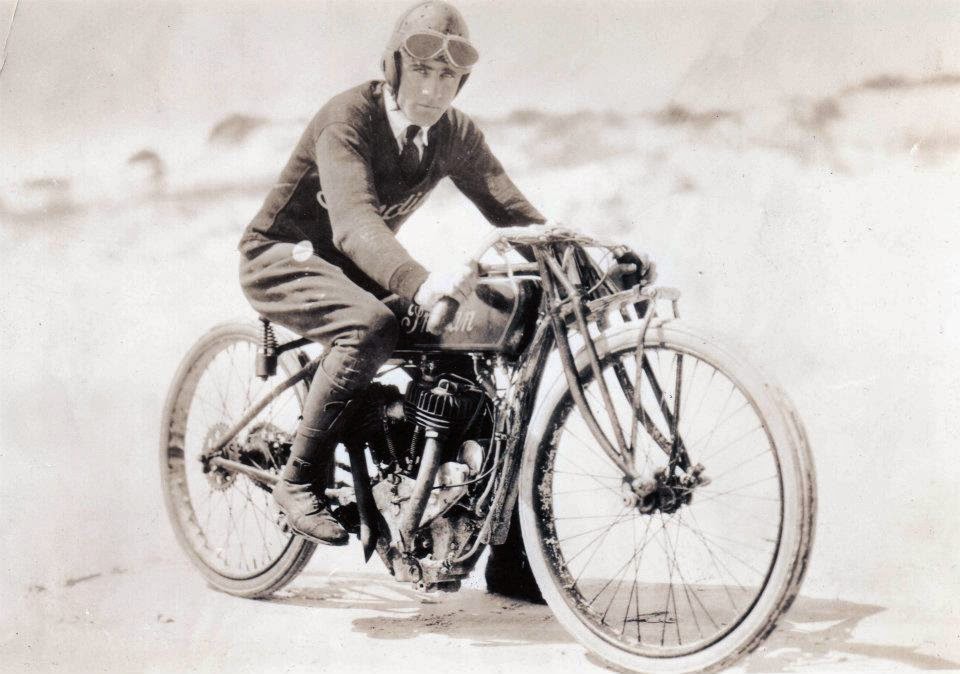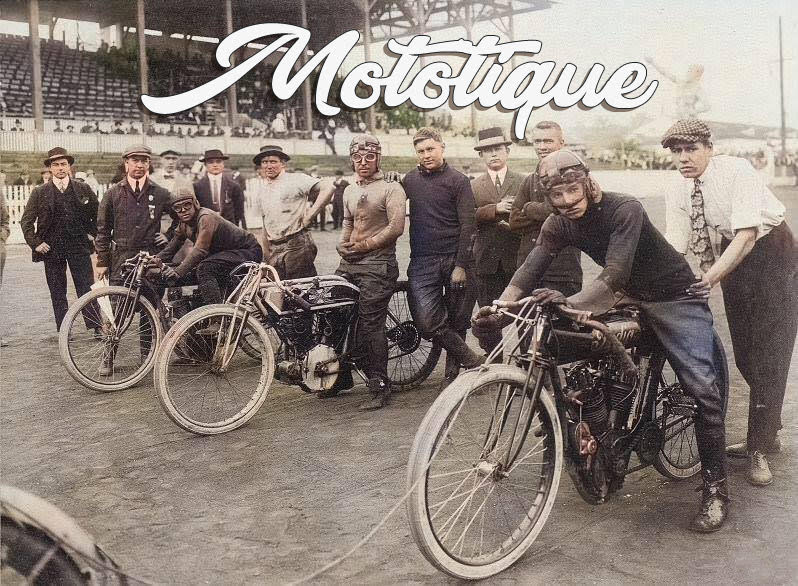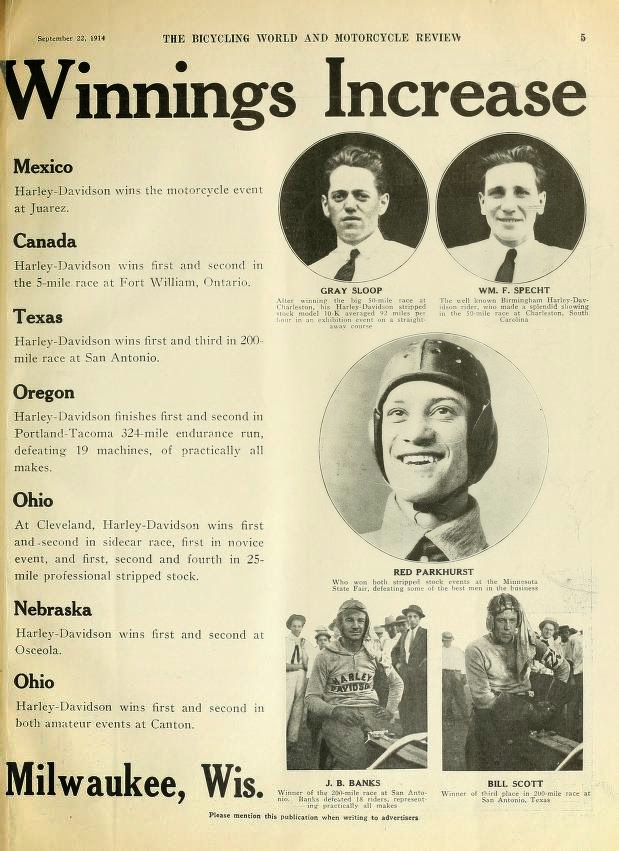January 28, 2015
Updated - February 20, 2015
@MototiqueRacing
Ocala, Florida
This early 1920s photo of a man at the beach on an Indian Motocycle keeps showing up on social media, but few people know the story behind it. It is the story of three men from Birmingham, Alabama, each of whom played a part in early motorcycle racing history. Time to tell their story.
Herbert Foster McBride Sr., also known as Percy, was born in Jefferson County, Alabama in 1901. Like many young men of this time, he was drawn to the freedom, and excitement of early motorcycles. How Herbert McBride was introduced to motorcycles has been lost to time, but eventually the sixteen-year-old McBride, landed a job working in the machine shop of William F. Specht Jr's Harley-Davidson Motorcycles machine shop in downtown Birmingham, Alabama.
Also working in the machine shop at the time, was an up-and-coming local racer named Gene Walker. With the help of the Birmingham Indian Motocycles dealer, Robert Stubbs, Walker built a winning reputation, in the races on the one-mile dirt oval at the Alabama State Fairgrounds in Birmingham. In 1915, Walker was hired as a member of the Indian Motocycles Factory Racing Team, and relocated to their headquarters in Springfield, Massachusetts.
With the approach of America's involvement in World War 1 in 1917, professional motorcycle racing shut down, and Walker returned to Birmingham. Both Walker, and McBride were exempt from the 1917 military draft. Walker was the sole support for his widowed mother, and McBride was too young. Walker, and McBride, worked together at Specht's machine shop for the next year or so. With then end of the war in 1918, Walker returned to the professional racing, while McBride remained working as a machinist in Birmingham, but switched to working for Bob Stubbs at the Birmingham Indian dealership.
At the end of a successful 1919 racing season, the Indian Motocycles Factory Racing Team, decided they would go after the existing motorcycle speed records at Ormond Beach, Florida in April 1920. Beginning in 1909, racers used the sands of Ormond Beach, Florida for motorcycle speed records. The course was laid out along the beach, at low tide. Gene Walker's former boss at the Birmingham Indian dealer, Robert Stubbs, was a member of the Indian Motocycles Factory Racing Team in the 1909 Ormond Beach event.
Stubbs still had considerable influence with the Indian factory, and Gene Walker was chosen to go after the existing professional class speed records in 1920.
For this attempt, Indian built racing bikes with four different engines. They were the eight valve V twin, the Power Plus side valve racing V twin racing, a stock 61ci Production side valve V twin, and a four-valve racing single. A decision was made to go after both the National records measured in miles, and the international records measured in kilometers in both the amateur, and professional classes.
The decision to also go after the amateur records, opened a slot on the team for another team rider, who was not a professional racer. Gene Walker recommended his friend from Birmingham, Herbert McBride, to be his amateur teammate. This was a great opportunity for McBride, who would ride some of the best racing bikes in the country, under the supervision of one of the countries' most successful professional racers. It did not take long for McBride to accept Walker's invitation.
Between April 12, and April 15, Walker, and McBride set twenty-four new National, and International motorcycle speed records. Walker was credited with the first official F. I. M. World Motorcycle Speed Record of 104.12 mph. on a stock 61ci side valve Indian Scout. Walker also set a new National Motorcycle Speed Record of 115.79 mph. on an eight-valve racer. Walker's faith in his amateur teammate was well placed, as McBride's new amateur record speeds were higher than the previous professional class records. The new records received coverage in newspapers across the country.
The new records were touted in Indian Motorcycles advertising and were covered in the May 1920 edition of Indian's newsletter, known as Wigwam News. As a result of the new records set by Walker, and McBride, the Indian Power Plus production bikes, would come to be known as "Daytona Racers".
With the records set, and the hoopla over, Hebert McBride returned to his job a a machinist at the Indian dealership. In October of 1921, "Percy" McBride was mentioned as an entry for a contestant in a 500-mile motorcycle endurance race through Georgia, and Alabama.
Ancestry.com
Atlanta Constitution
Bettman Image Collection
Birmingham News
Birmingham, Alabama Public Library Archives
Carol Watson Collection
Chris Price @ Georgia Motorcycle History
Don Emde Collection
Motorcycle and Bicycle Illustrated
Newspapers.com
R. I. Jones Collection
The Washington Times
Wigwam News
 |
| Herbert McBride - Ormond Beach, FL. - April 1920 Bettman Image Collection |
Herbert Foster McBride Sr., also known as Percy, was born in Jefferson County, Alabama in 1901. Like many young men of this time, he was drawn to the freedom, and excitement of early motorcycles. How Herbert McBride was introduced to motorcycles has been lost to time, but eventually the sixteen-year-old McBride, landed a job working in the machine shop of William F. Specht Jr's Harley-Davidson Motorcycles machine shop in downtown Birmingham, Alabama.
Also working in the machine shop at the time, was an up-and-coming local racer named Gene Walker. With the help of the Birmingham Indian Motocycles dealer, Robert Stubbs, Walker built a winning reputation, in the races on the one-mile dirt oval at the Alabama State Fairgrounds in Birmingham. In 1915, Walker was hired as a member of the Indian Motocycles Factory Racing Team, and relocated to their headquarters in Springfield, Massachusetts.
 |
| Gene Walker - Birmingham, AL. O. V. Hunt - 1914 (cropped) |
With the approach of America's involvement in World War 1 in 1917, professional motorcycle racing shut down, and Walker returned to Birmingham. Both Walker, and McBride were exempt from the 1917 military draft. Walker was the sole support for his widowed mother, and McBride was too young. Walker, and McBride, worked together at Specht's machine shop for the next year or so. With then end of the war in 1918, Walker returned to the professional racing, while McBride remained working as a machinist in Birmingham, but switched to working for Bob Stubbs at the Birmingham Indian dealership.
At the end of a successful 1919 racing season, the Indian Motocycles Factory Racing Team, decided they would go after the existing motorcycle speed records at Ormond Beach, Florida in April 1920. Beginning in 1909, racers used the sands of Ormond Beach, Florida for motorcycle speed records. The course was laid out along the beach, at low tide. Gene Walker's former boss at the Birmingham Indian dealer, Robert Stubbs, was a member of the Indian Motocycles Factory Racing Team in the 1909 Ormond Beach event.
 |
| Robert Stubbs - Ormond Beach, FL. - March 1909 Chris Price @ Georgia Motorcycle History |
 |
| Gene Walker Ormond Beach, FL. - April 1920 Don Emde Collection |
 |
| 1920 Indian Eight Valve Racer R. I. Jones Collection |
Between April 12, and April 15, Walker, and McBride set twenty-four new National, and International motorcycle speed records. Walker was credited with the first official F. I. M. World Motorcycle Speed Record of 104.12 mph. on a stock 61ci side valve Indian Scout. Walker also set a new National Motorcycle Speed Record of 115.79 mph. on an eight-valve racer. Walker's faith in his amateur teammate was well placed, as McBride's new amateur record speeds were higher than the previous professional class records. The new records received coverage in newspapers across the country.
 |
| Oregon Daily Journal - May 9, 1920 |
 |
| Motorcycle and Bicycle Illustrated - April 1920 |
 |
| The Washington Times (Washington, DC.) - May 8, 1920 |
The new records were touted in Indian Motorcycles advertising and were covered in the May 1920 edition of Indian's newsletter, known as Wigwam News. As a result of the new records set by Walker, and McBride, the Indian Power Plus production bikes, would come to be known as "Daytona Racers".
 |
| Indian Motorcycle Ad - May 1920 |
 |
| Wigwam News - May 1920 Furman Family Collection |
 |
| May 1920 Wigwam News Carol Watson Collection |
 |
| Atlanta Constitution - October 16, 1921. |
In November 1921, Herbert McBride married Amy Bell George, and retired from motorcycle competitions. McBride took a job as a Plymouth/DeSoto automobile salesman for Street Motors in Birmingham. They had a son, Herbert Foster McBride Jr.
With his retirement from motorcycling, McBride could look back with pride to those four days in April 1920, when he set twelve new speed records, and was the Fastest Amateur Motorcyclist in the World. Not a small achievement for a young man from Birmingham.
Epilogue:
Three years after the Ormond Beach Record runs, Gene Walker died of injuries from a practice crash in East Stroudsburg, Pennsylvania. He was returned to Birmingham and buried at historic Elmwood Cemetery.
With his retirement from motorcycling, McBride could look back with pride to those four days in April 1920, when he set twelve new speed records, and was the Fastest Amateur Motorcyclist in the World. Not a small achievement for a young man from Birmingham.
Epilogue:
Three years after the Ormond Beach Record runs, Gene Walker died of injuries from a practice crash in East Stroudsburg, Pennsylvania. He was returned to Birmingham and buried at historic Elmwood Cemetery.
 |
| Birmingham News - June 24, 1924 |
For more information on Gene Walker's career, please check out Episode #2 - Gene Walker Birmingham's Lost Racing Champion at:
For more information on Robert Stubbs' career, please check out Episode # 6 Bob Stubbs Birmingham's First racing Champion at:
Herbert Foster McBride Sr. died in Birmingham, Alabama in 1946. He was buried at Elmwood Cemetery, not far from his friend, and racing mentor Gene Walker.
Sources:
Robert Stubbs died of cancer in 1922, and was buried at Eastlake Cemetery in Birmingham.
For more information on Robert Stubbs' career, please check out Episode # 6 Bob Stubbs Birmingham's First racing Champion at:
Herbert Foster McBride Sr. died in Birmingham, Alabama in 1946. He was buried at Elmwood Cemetery, not far from his friend, and racing mentor Gene Walker.
 |
| Elmwood Cemetery Section #23 Birmingham, Alabama |
Sources:
Ancestry.com
Atlanta Constitution
Bettman Image Collection
Birmingham News
Birmingham, Alabama Public Library Archives
Carol Watson Collection
Chris Price @ Georgia Motorcycle History
Don Emde Collection
Motorcycle and Bicycle Illustrated
Newspapers.com
R. I. Jones Collection
The Washington Times
Wigwam News



























